| Home | ||
|---|---|---|
The Cave People
The Spider People
The Winged People
The Mountain People
The People of the Whole (Kakiu)
The Crystal People
The Deer People and
The Snake People
Though Kiuses live all over their world, few races know of the existence of all the others - save the Mountain People and the Spider Kius Grand Chief. Most races are only aware of those living in the same Territory as them. The "older" races - which are the Cave, Spider, Mountain and Winged - know of each other even though the Winged have lived for centuries in the isolation of their rain forests. The Kakiu also know only of these four races. The "younger" races - those who came after the older ones (evolutionarily speaking) and include the Crystal, Deer and Snake - are only vaguely aware of the older races.
You'll eventually be able to click here to find out more specifics on Kius culture.
| The Cave People (Le-kayotu Kius: pronounced: lee-kay-oh-too) | |
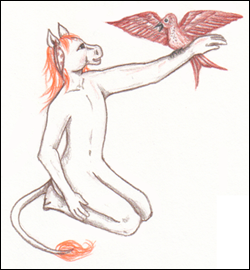 |
Where they live: Lightly forested areas of the North-West Territory Reason for name: Being one of the oldest races, Cave Kiuses used to live as village groups in caves. They were - and still are - excellent stone workers despite the fact they have never used metal tools. They would often altered their cave homes to suit their needs and evidence of their early cave-dwelling times still exist today even though they almost exclusively now make their homes above ground. Distinguishing feature: Cave Kiuses wear ear-feathers that denote their social status within the village. Homes: The homes of choice for the Cave People are round, one-roomed dwellings standing about eight feet high. They're made from earthen bricks and have thatched roofs. Food: Cave Kiuses hunt and grow crops as well as gather plants, roots and berries near their villages. Their primary game is deer and raneps, as well as a wide variety of small mammals. Their crops consist of plants that are difficult to find or gather beyond the village. Though fish are often available in the large bodies of water or rivers a village may be near, Cave Kiuses rarely eat fish. |
| Back to list | |
| The Spider People (Le-mae Kius: lee-ma-ee) | |
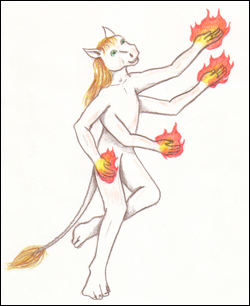 |
Where they live: Spider Kiuses are desert dwellers who live in the drier regions of the North-West Territory Reason for name: There are actually a couple reasons Spider Kiuses are called such: One is that they have four arms as opposed to the usual two of the other races. The second is they delight in eating roasted spiders. Distinguishing feature: Their afore mentioned four arms Homes: Spider Kiuses homes are round, domed-roofed structures made of fire-baked brick. They are one-roomed and can stand anywhere from fifteen to twenty feet tall and are dotted with many windows that can be covered or uncovered to regulate internal temperatures. Food: Like their Cave Kius neighbors, they too grow crops and hunt for food. To help protect their crops from the intense desert sun, most villages cultivate two trees near their village which provide shade and a water source for the plants they grow. To maintain soil quality and to not stress the parent trees, crops are rotated on a four-year basis from the base of one tree to the other. Common colors: Orange and brown are the most common mane colorings, with brown and black taking the top eye color spot. Blue eyes are rare with green being even more uncommon. |
| Back to list | |
| The Winged People (Le-na-hunra Kius: lee-na-hoon-ra) | |
 |
Where they live: The rain forests of the South-West Territory Reason for name: These People do indeed have wings and can fly. Distinguishing feature: Their large, bat-like wings Homes: They make their homes in hollowed out knots in the ancient trees and one tree and support an entire village population. Food: Winged Kiuses have no formal agriculture and instead gather fruits, nuts and berries from the abundant environment around them. They are however, expert spear and blow-dart hunters and make as their prey the small mammals and lizards that live in the rain forests. Common colors: Pale mane and eyes colors of nearly every shade are prevalent among this race. Other points of interest: The Winged people are the smallest Kius race and rarely stand over five feet tall. |
| Back to list | |
| The Mountain People (Le-vanrotay Kius: vahn-roh-tay) | |
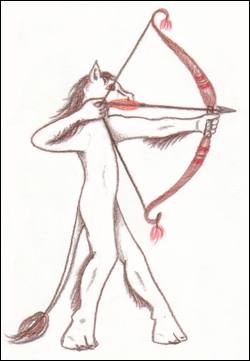 |
Where they live: This race lives in the Great Mountains - an extensive ridge that runs the entire length of the planet from pole to pole. Some exist nomadically, always moving from one place to another, following the herds they hunt. Others live in permanent villages Reason for name: Where they live, as mentioned above Distinguishing feature: Mountain Kiuses are a rugged, almost stocky race with stiff, bristly hair growing down the backs of their arms and legs which provides them with added warmth and protection against the harsh - often cold - climates they inhabit. Homes: Those who live in stationary villages make their low homes out of native stone to blend into the surrounding terrain and can be hard to spot if you don't know what to look for. Those who wander, travel with animal-hide tents that can be erected and taken down quickly. Because of their mobility, these dwellings tend to be heavily decorated and flashier than their stone counterparts. Food: Mountain Kiuses eat just about anything that moves or grows. Being the only race that uses metal, it shows up predominately in tools they use to till the earth and harvest crops as well as in hunting weapons. Common colors: Darker shades of brown and black for both manes and eyes. Other points of interest: Very likely the oldest race; their Story Tellers are the keepers of all Kius history. |
| Back to list | |
| The People of the Whole (Le-osham Kius: lee-oh-sham) aka: Kakiu: ka-ki-oo | |
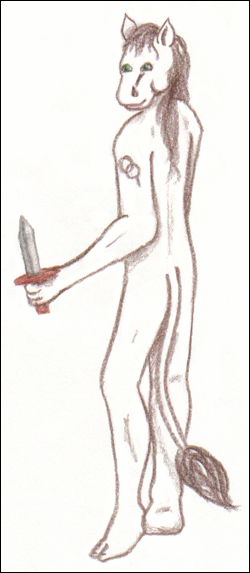 |
Where they live: Along the coastal and river regions of the North-West Territory Reason for name: The People of the Whole believe themselves to be the culmination of the gods' plans. Distinguishing feature: Since any race can be Osham, the only way to distinguish them from other races is the Mark (Peosham: pee-oh-sham) that is branded on the arm of all People of the Whole. Homes: Osham homes are two-storied, square structures made of fire-baked brick. The first story is used for cooking and to serve as shelter from inclement weather, the second story - which can be roofless in some regions - is used for sleeping, eating and other family activities. Food: People of the Whole grow their crops in the rich, fertile soil of the river deltas and valleys around which they live. They hunt as well as gather food around their villages. Though fish and other sea creatures are prevalent in the ocean, few Osham People eat salt-water fish - or even venture into the sea at all - instead they prefer fresh-water varieties. Common colors: As this is the only race to encourage interracial joining, colorings that are uncommon in the other races - like spots, brindling or unusual mane or eye colorings and combinations - crop up more frequently among the People of the Whole. Other points of interest: The People of the Whole are the newest race - having been around for only 1200 or so years. Their presence though, has greatly impacted their world and is the reason many races live where they do today as well as why many are as isolated as they are. |
| Back to list | |
| The Crystal People (Le-kashean Kius: lee-kash-ee-ahn) | |
 |
Where they live: This race inhabits the coastal areas of the South-East Territory Reason for name: Their exquisite gem-crafting that is second to none. Crystal Kiuses not only make beautiful jewelry, by they use gems and crystals in everything from weapons to tools to household decorations. Distinguishing feature: This race is an evolutionary off-shoot from the Winged Kiuses and though they have no wings themselves, they share in that race's small stature. Homes: Their homes tend to be small dwellings with two or three rooms, made of sod and thatch. Food: Crystal Kiuses hunt very little, their primary source of meat being the fish they catch in the warm costal waters - they are the only race who build boats and eat fish from the Great Ocean. Their agricultural skills on the other hand, are rather advanced compared to the other races and they rarely need to venture far from their villages for food. Common colors: Like the Winged People, pale manes are the most common; though their eye colors tend to be richer and more jewel toned (no pun intended) than their Winged cousins. Other points of interest: Though they themselves do not produce metal tools for their craft, they happily trade their wares with the Mountain People - who do work in metal and love providing this race with tools to improve their skills. |
| Back to list | |
| The Deer People (Le-naku Kius: lee-na-koo) | |
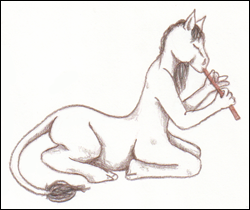 |
Where they live: The woodlands of the North-East Territory Reason for name: Deer Kiuses have four legs (like centaurs) and are swift runners. Distinguishing feature: Aside from their quadrupedal anatomy, Deer Kiuses also have a brown tint to their fur - the fur of all other races tends to be a more intense white. Homes: Deer Kiuses are nomadic and prefer to live and sleep out in the open. Some of the more northern dwelling groups may stay in one place for up to a year, but most of them move daily within a sizable travel radius. If there is any need for shelter - unusually violent weather, or a need to shelter one who is sick - most village groups travel with woven grass mats that can be quickly assembled to form a stable, domed structure that can house anywhere from two to eight people. Food: They are the only race that does not hunt animals - though the do enjoy eating insects. Their diet is mostly plant based and rarely cooked. Common colors: Black and darker shades of brown are the most common mane and eye colors. Other points of interest: Like all the "younger" races, they have weaker pyrokinetic skills and can only create fire in small bursts - in their case, for self-defense against large predatory beasts who roam their lands. |
| Back to list | |
| The Snake People (Le-pakay Kius: lee-pa-kay) | |
 |
Where they live: This race lives in the barren hills of the North-East Territory Reason for name: Their pyrokinetic and telepathic skills are the weakest of all the races, however, they make up for it with remarkable telekinetic abilities. Snake Kiuses are a race of shape-shifters - able to change their physical form at will. The first form every child learns is the snake - hence their name. Distinguishing feature: Their shape-shifting ability Homes: Snake Kiuses carve out their homes from the soft-stoned hillsides of their region. Food: Like the Mountain People, they eat just about anything they can catch, hunt or gather. The soil is too poor to support organized agriculture, and they instead nurture any food-baring plant that grows near their villages. Common colors: Dark shades of brown, orange or black are the most common mane colors. Their eyes tend to be brown, dark blue or dark green, while black - oddly enough - being rather uncommon. Other points of interest: The Snake People have been charged by the Mountain Kiuses to protect the Deer People - who also live in this Territory - from the Kakiu since only a small mountain range separates them from the quiet woodland dwellers. The Snake Kiuses have taken up this charge with relish as they love their four-legged neighbors and refer to them as Gentle Children. Small detachments of Snake Kiuses patrol those hills and they kill any Kakiu who come through the mountains. Since no Kakiu has ever gone into the mountains and returned, the existence of the races of the North-East lands remains a secret from them. The mountains have also - understandably - taken on the reputation of being dangerous and haunted by deadly spirits. |
| Back to list | |